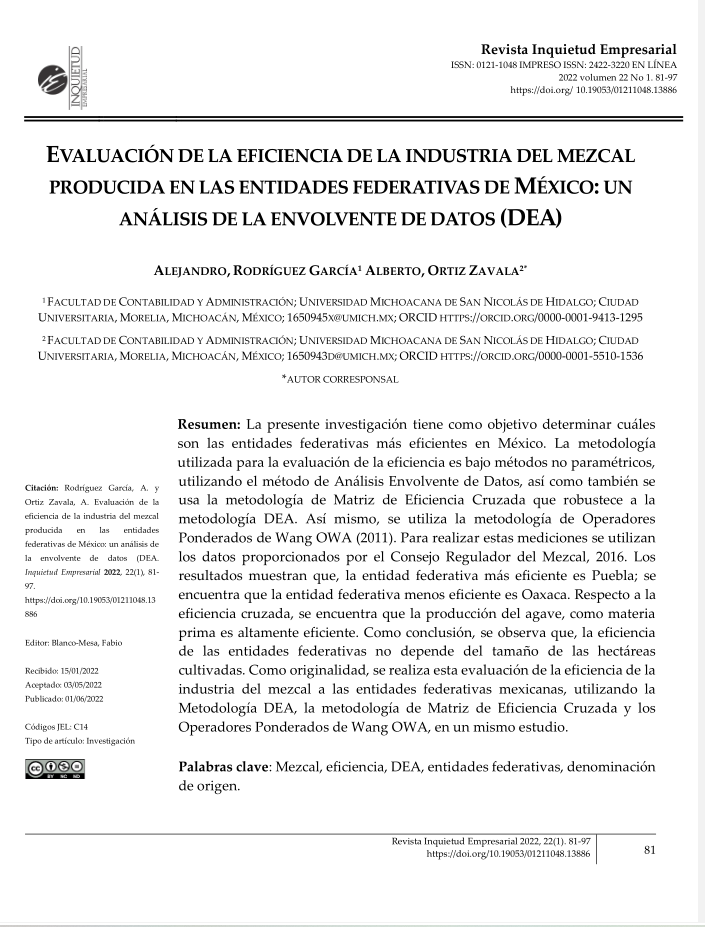Evaluation of the Efficiency of the Mezcal Industry Produced in the Mexican States: a Data Envelopment analysis (DEA)

Abstract
The objective of this research is to determine which are the most efficient states in Mexico. The methodology employed for the evaluation of efficiency is based on non-parametric methods; the data envelopment analysis method, the cross-efficiency matrix methodology that strengthens the DEA methodology, and the Wang weighted operators (OWA) methodology (2011) are used. For these measurements, the data provided by the Mezcal Regulatory Council (2017) were utilized. The results show that the most efficient federal entity is Puebla and the least efficient is Oaxaca. Regarding cross-efficiency, it is found that the production of agave, as a raw material, is highly efficient. As a conclusion, it is observed that the efficiency of the states does not depend on the size of the cultivated hectares. Regarding originality, this evaluation of the efficiency of the mezcal industry in the Mexican states uses the DEA methodology, the crossed efficiency matrix methodology and Wang’s Weighted Operators (OWA) in the same study.
JEL Codes: C14
Received: 15/01/2022. Accepted: 03/05/2022. Published: 01/06/2022.
Keywords
mescal, efficiency, DEA, states, designation of origin
Author Biography
Alejandro Rodríguez García
Alejandro Rodríguez García
Doctorante en Administración por la Universidad Michoacana de San Nicolás de Hidalgo en Morelia, Michoacán, México, con Maestría en Negocios Internacionales por la misma universidad.
Alberto Ortiz Zavala
Alberto Ortiz Zavala
Doctorante de la Universidad Michoacana de San Nicolas de Hidalgo, en Morelia, Michoacán, México, con Maestría en Negocios Internacionales por la misma universidad.
References
- Cervantes, R. M. C. (2002). Plantas de importancia económica en las zonas áridas y semiáridas de México. Universidad Nacional Autónoma de México. http://www.publicaciones.igg.unam.mx/index.php/ig/catalog/view/127/120/416-1
- Chowdhury, M., & Haron, R. (2021). The Efficiency of Islamic Banks in the Southeast Asia (SEA) Region. Future Business Journal, 7(16) 200-230. https://doi.org/10.1108/08288660810851450
- Coll, S. V. & Blasco, B. O. (2006). Evaluación de la eficiencia mediante el análisis envolvente de datos. Eumed.net. Recuperado el 17 de noviembre de 2020, de https://www.eumed.net/libros-gratis/2006c/197/index.htm
- Consejo Mexicano Regulador de la Calidad del Mezcal. (2017). Informe de actividades. Consejo Regulador del Mezcal.
- Consejo Mexicano Regulador de la Calidad del Mezcal. (2020). Informe de actividades. Consejo Regulador del Mezcal.
- Cooper, W., Seiford, L., & Tone, K. (2006). Introduction to Data Envelopment Analysis and Its Uses. Springer.
- Diario Oficial de la Federación. (1994, 28 de nov.). Resoluciones. Secretaría de Comercio y Fomento Industrial. DOF.
- Farfán, H. J. & Ruiz Fernández, F. A. (2019). Eficiencia en instituciones microfinancieras. Universidad del Pacífico.
- Farrell, M. J. (1957). The Measurement of Productive Efficiency. Journal of the Royal Statistical Society, 120(3), 253-290.
- Financiera Rural. (2021). Monografía del mezcal. Dirección Ejecutiva de Análisis Sectorial.
- Guede-Cid, M. (2011). La eficiencia de los centros públicos de investigación en el proceso de transferencia de conocimiento y tecnología. Universidad Rey Juan Carlos. http://hdl.handle.net/10115/11651
- Gutiérrez, N. B., Mar, M. C., & Serrano, C. (2007). Microfinance Institutions and Efficiency. Omega, 35(2) 131-142. https://doi.org/10.1016/j.omega.2005.04.001
- López, N. G. (2020). La cadena de suministro del mezcal del estado de Zacatecas. Contaduría y Administración, 59(2), 227-252. https://doi.org/10.1016/S0186-1042(14)71261-6
- McGlynn, E. A. (2008). Identifying, Categorizing, and Evaluating Health Care. U.S. Department of Health and Human Services. https://doi.org/10.1111/j.1468-0009.2008.00537.x
- Melone, G., & Rojas, C. (2020). Eficiencia de la banca microfinanciera venezolana. Universidad Católica Andrés Bello.
- Navarro, J. C. (2005). La eficiencia del sector eléctrico en México. ININEE-UMICH.
- Navarro, J. & Delfín, O. (2014). La eficiencia de los puertos en México (1.a ed.). Universidad Michoacana de San Nicolás de Hidalgo.
- Ramanathan, R. (2003). An Introduction to Data Envelopment Analysis. Sage Publications.
- Real Academia Española. (2019). Eficacia. https://dle.rae.es/eficacia
- Rodríguez, J. M., Angón, E., González, M. A., Perea, J., Barba, C., & García, A. (2017). Allometric Relationship and Growth Models of Juveniles of Cichlasoma festae (Perciforme: Cichlidae), a Freshwater Species Native in Ecuador. Revista de Biología Tropical, 65(3), 1185-1193.
- Saldaña, R. A., (2012). Estudio de la eficiencia del agave tequiliana weber. Revista Mexicana de Ciencias Agrícolas, 3(4), 609-616.
- Sánchez, D. G. (2020). Aislamiento y eficiencia de levaduras nativas de tinas fermentadoras para maguey (Agave cupreata Trel. & Berger). Agro Productividad, 13(3) 45-60. http://dx.doi.org/10.32854/agrop.vi.1639
- Sexton, T. R., Silkman, R. H., & Hogan, A. J. (1986). Data Envelopment Analysis: Critique and Extensions. Jossey-Bass. https://doi.org/10.1002/ev.1441
- Sistema de Información Agroalimentaria y Pesquera. (s.f.). Reportes. gob.mx: https://www.gob.mx/siap
- Thanassoulis, E. (2001). Introduction to the Theory and Application of Data Envelopment Analysis: A Foundation Text with Integrated Software. Springer.
- Torres S. M. (2017). La eficiencia de la industria de alimentos, bebidas y tabaco en México, Estados Unidos, Canadá y Brasil, en el período 2000-2014, un análisis a través de la envolvente de datos (DEA). ININEE, UMSNH.
- Wang, Y. M. (2011). The Use of OWA Operator Weights for Cross-Efficiency Aggregation. Omega, 39(5), 493-503. http://dx.doi.org/10.1016/j.omega.2010.10.007
- Zizumbo Villarreal, D. G. (2009). Destilados en Mesoamérica oriental antes de la llegada de los europeos. Economic Botany, 63(4), 413-426.
